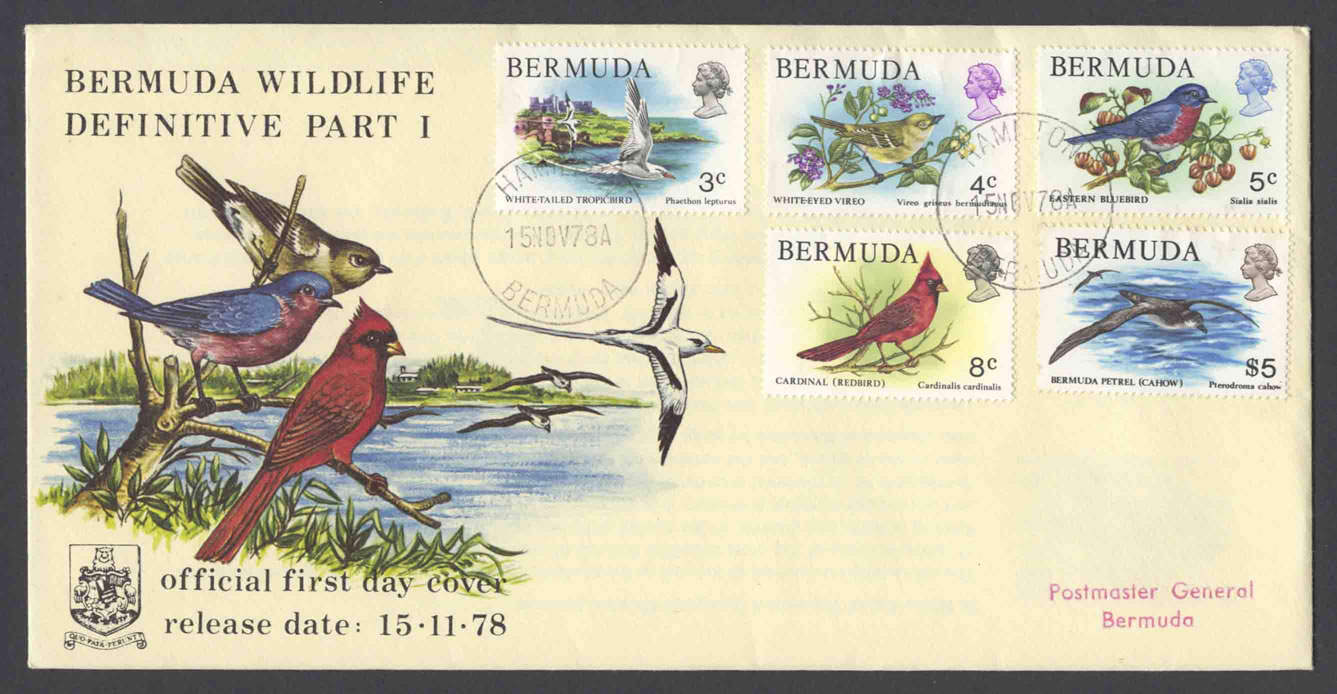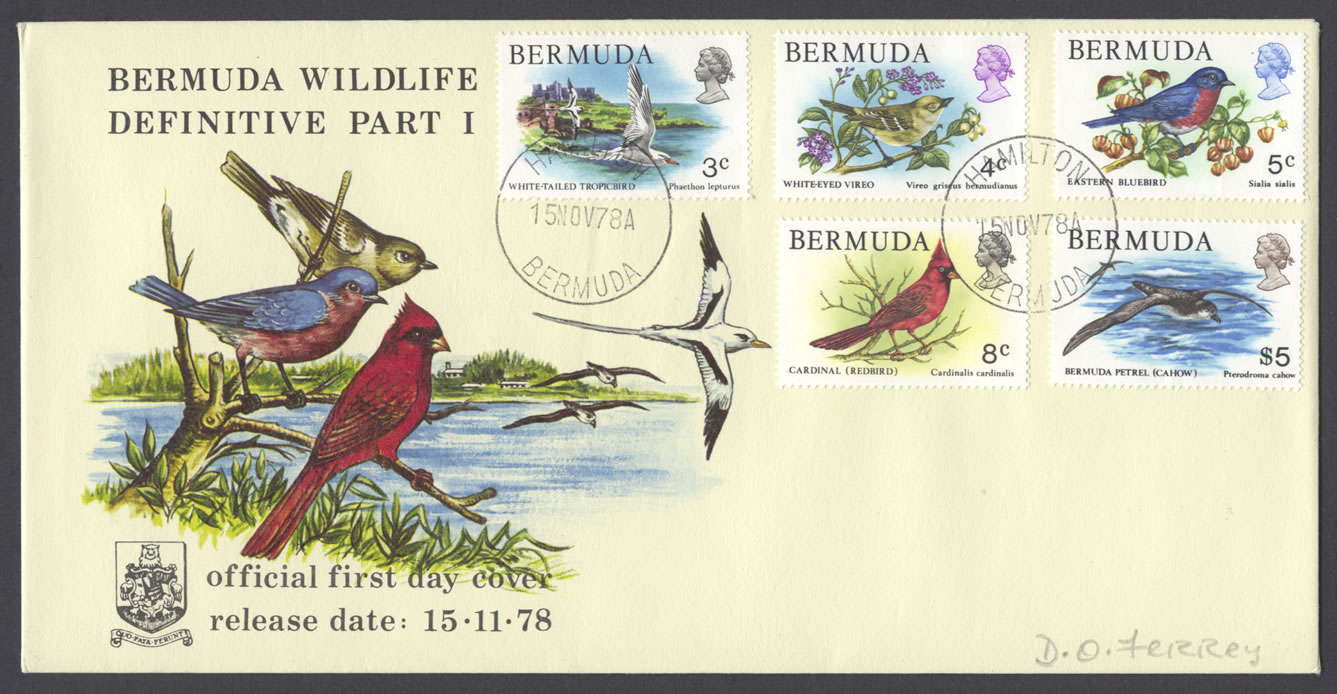Your basket is currently empty!

1978 Bermuda Wildlife Definitive Part I
New definitive wildlife issue
Date: 15th November 1978
Stamps: 3c White-Tailed Tropicbird Phaethon lepturus; 4c White-Eyed Vireo Vireo Griseus bermudianus; 5c Eastern Bluebird Sialia sialus; 8c Cardinal (Redbird) Cardinalis cardinalis and $5 Bermuda Petrel (Cahow) Pterodroma cahow
Type: Official First Day Cover
Cachet: BERMUDA WILDLIFE DEFINITIVE PART I. offical first day cover /release date: 15.11.78
CDS: 15NOV78A SOMERSET BRIDGE BERMUDA
Address: Crown Agents Stamp Bureau, 4 Millbank, London SW1
Liner
BERMUDA WILDLIFE PART I
Theme “Bermuda Birds” By David Wingate. MBE., B.A., Conservation Officer, Bermuda Department of Agriculture & Fisheries.
Technical Details
Designer: Gordon Drummond
Printer: Harrison & Sons (High Wycombe) Ltd.
Process: Photogravure
No. of stamps per sheet: 50 (2 Panes of 25)
Size of stamps: 28.45mm x 42.58mm
Paper: C.A. watermark
Release Date: 15th November, 1978
3c White-Tailed Tropicbird (Longtail) Phaethon lepturus
The while-tailed tropicbird or longtail as Bermudians know it is Bermuda’s traditional harbinger of spring and one of the most beautiful features of our coastline during the summer months. Nesting in holes and crevices 0f the coastal cliffs and islands where it is safe from human disturbance and introduced mammal predators, it is the only native seabird to have survived in numbers comparable to its primeval abundance on Bermuda. At least 3,000 nesting pairs still breed along most of the coastline, but the numbers are declining slowly due to coastline development, increased disturbance and predation by stray dogs and oil pollution a sea.
Longtails have such small feet that they are unable to walk on land and hence do all their nest searching on the wing. It is this constant searching back and forth along the cliffs, combined with the aerial courtship display. which involves touching the tips of the long tail leathers together in paired flight. that makes them so conspicuous on our coastline. The single purplish-red speckled egg is laid in April and hatches in late May. The chick takes approximately 65 days to fledge and departs to sea on its own in late July or early August.
Longtails do all of their feeding far out on the open ocean where they plunge from a height onto unsuspecting fish and squid like a gannet. During the winter months the population disperses throughout the Sargasso Sea and remains out of sight of land. Evidently, the birds sleep on the wing or on the water if it is calm.
4c White-Eyed Vireo Vireo griseus bermudianus
The white-eyed vireo is known to Bermudians as the “chick of the village” In imitation of its cheery song which is sung throughout the year. It has the distinction of being an endemic sub-species, characterised by shorter wings and duller plumage in comparison with its American counterpart. An insect-eating bird of the forest canopy, it was originally associated with Bermuda’s ubiquitous cedar and palmetto forest. Although periodic deforestation after human settlement and more reccntly, the almost total destruction of the cedar tree by accidentally introduced insect pests nearly caused its extinction, this bird has recovered well again over the last two decades as the result of extensive reforestation.
5c Eastern Bluebird Sialia sialis
It is said that the bluebird carries the sky on its back and earth on its breast. Bermuda is fortunate indeed to be able to claim this beautiful, useful and confiding songbird amongst its native land bird fauna. Throughout most 0f our history since human settlement the bluebird was very abundant, nesting in hollows of the cedar trees, In coastal cliffs and even under the eaves of houses. As a cavity nester, however. It became especially vulnerable to nest site competition from the house sparrow following its introduction in 1870, more recently. the s ling, which colonised Bermuda in the 1950s. The loss of Bermuda’s cedar forest due to introduced insect pests and the subsequent removal of dead trees aggravated this problem even more by reducing the number of available nesting hollows. It is estimated that between 1950 and 1978, the population declined by more than 80 per cent. Extensive community participation in an artificial nest box programme may now be the only factor preventing the total extinction of the bluebird on Bermuda.
8c Cardinal Cardinalis cardinalis
The cardinal or “redbird” as most Bermudians know it, was probably first introduced to Bermuda as a cage bird from Virginia about 1700. It rapidly became abundant and during the nineteenth century thousands were trapped for resale as cage birds abroad. Although fully protected today. it is much less common as a result of competition from other introduced birds. It remains conspicuous, however, because of its bright plumage, loud cheery song and its attraction to bird feeders where it shows a preference for sunflower seeds.
$5.00 Bermuda Petrel (Cahow) Pterodroma cahow
When the first settlers landed on Bermuda, they found it teaming with if nocturnally active seabird that they called the cahow in imitation of its eerie call. It was so tame and defenceless. however, and such good eating that it was soon reduced to the point of oblivion. For three centuries thereafter it remained lost to science until R. W. Shufeldt described it as an endemic form of Gadfly petrel from the abundant fossil bones in Bermuda’s limestone caves in 1915. Soon after this publication, an extraordinary fact came to light. Live specimens fitting Shufeldt’s description had been collected on Bermuda In 1861 and again in 1906. Incredibly. Incredibly, a few cahows had managed to survive undetected for all that time. When two other freshly killed specimens were subsequently found in 1935 and 1945 respectively. Dr. Robert Cushman Murphy, the world authority on oceanic birds at the American Museum, decided to mount a special search expedition in team with Louis S. Mowbray of the Bermuda Aquarium. The expedition of 1951 was immediately successful in relocating the breeding grounds, and thus made it possible to launch a conservation programme for the species. After 25 years of intensive management, the callow has begun a slow recovery from an estimated 18 pairs in 1951 to 27 pairs in 1978
[hr]
Type: Registered First Day Cover
CDS: 15NOV78B HARRINGTON SOUND BERMUDA
Registration Label: Harrington Sound, Bermuda No 0412
Address: Sheringham, Norfolk
[hr]
Type: Official First Day Cover
Cachet: BERMUDA WILDLIFE DEFINITIVE PART I. offical first day cover /release date: 15.11.78
CDS: 15NOV78A HAMILTON BERMUDA
Address: Postmaster General Bermuda
[hr]
Type: Official First Day Cover
Cachet: BERMUDA WILDLIFE DEFINITIVE PART I. offical first day cover /release date: 15.11.78
CDS: 15NOV78A HAMILTON BERMUDA
Address: D.O. Ferrey
by
Tags:



Leave a Reply
You must be logged in to post a comment.